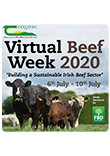
Agricultural Emissions - greenhouse gases and ammonia
Type Media Article
Greenhouse gases (GHG’S) and air pollutants are the two main categories of Agricultural emissions. Greenhouse gases have a negative impact on climate change. Air pollutants other type of gaseous emissions from agriculture. They negatively impact on human and animal health
Download Publication (PDF)
Agricultural emissions are divided into two main categories-greenhouse gases (GHG’S) and air pollutants (Fig. 1).
Greenhouse gases have a negative impact on climate change and are methane (CH4), nitrous oxide (N2O) and carbon dioxide (CO2). In agriculture the first two are the most important. Unfortunately for Irish farmers, agriculture contributes over 30% of our national greenhouse gas emissions.

Methane represents around 2/3 of all GHG emissions; it is a gas that is produced as a by-product of ruminant’s digestive process.
Nitrous oxide is a gaseous form of Nitrogen and is responsible for 1/3 of GHG emissions in Ireland.
Sources - nearly 60% come from animals and 30% from soils that were fertilised by manures or synthetic fertiliser or animal grazing on pasture. The remaining 10% comes mainly from management of animal manures like housing during closed period and slurry storage.

Fig. 1. Gaseous emissions from agricultural sources.
Air pollutants like ammonia (NH3) are the other type of gaseous emissions from agriculture. They are not greenhouse gases, but they do negatively impacts on human and animal health while also damaging ecosystems.
Ammonia is a gaseous form of Nitrogen, the main ways in which it is lost in agriculture are the storage and application of organic manures, chemical fertiliser applications and grazing animals. In Ireland agriculture is responsible for 99% of all ammonia emissions, we have committed to reduce these emissions through EU targets, however since 2016 we have been exceeding our targets.
Solutions to emissions - suite of mitigation measures
There are many options available to reduce GHG and ammonia emissions that will at the same time improve on-farm efficiency and profitability. (See Table 1 below).
Breeding and animal health provide benefits mainly through better animal performance and reduced finishing times which in turn reduces methane emissions.
Optimising soil fertility and incorporation of clover allow for reducing N fertilisation rate without a yield penalty.
Protected urea is a fertiliser formulation that is proven to reduce ammonia emissions by over 70%, while also maintaining yields, once used as part of a fertiliser plan to maintain pH, P&K levels.
Extended grazing season focuses on manure management, through reducing quantity of animal manure being stored and land spread.
Low emission slurry spreading like the trailing shoe & band spreader have been proven to cut ammonia losses by 50% while also improving nutrient use of the slurry.
Slurry additives are being investigated to see their effectiveness in reducing emissions during storage and land spreading.
Through reducing N losses during storage and land spreading, more N is retained in the system and available as nutrient supporting plant growth.


